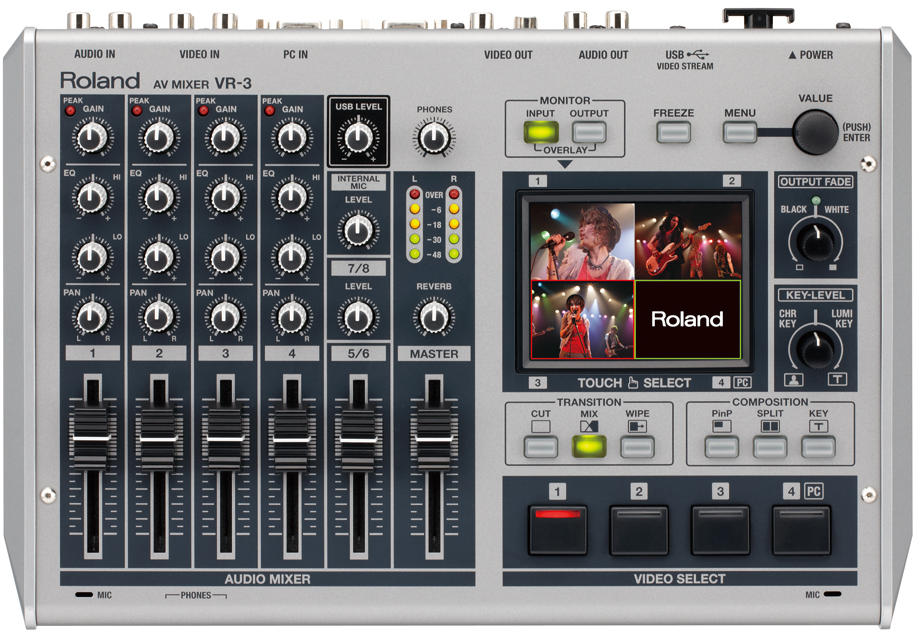Producing a Live Concert Webcast with the Next Computer Radius and the Roland VR-3
Video production and encoding expert Jan Ozer describes the workflow and challenges of a Livestream webcast he produced for marimba player Larissa Venzie using the Roland VR-3 and Next Computer's Radius portable workstation.
Shooting and Audio Setup
Working from the cameras in, I shot with two Canon XH A1s, one set up as the static back camera, the other driven by my colleague Scott Webster, close in on Larissa. I configured the cameras in 4:3 mode, interlaced. I shot 4:3 because of some misinformation that I had heard about the VR-3, specifically that it could only handle 4:3 input. I wish I had tested this beforehand, because after the concert, back in the lab, I tested 16:9 and it worked fine.
Though I prefer progressive mode when shooting for streaming, some SD mixers (and capture cards and hardware encoders, for that matter) have problems inputting progressive SD, since it's twice as many lines as they're used to. So I configured the XH A1s at 60i, saw no interlacing issues, and decided to stay at 60i.
For audio, I positioned two wired Shure SM57 dynamic microphones on each side of the instrument, pointing slightly down, as Larissa recommended. Apparently, though the big pipes on the marimba are located below the instrument, the sound pushes up through the keys, dictating microphone placement.
I could have connected the microphones directly into the Roland mixer, but wanted high-quality sound on tape for the on-demand streaming files I planned to produce after the concert. So I connected the microphones to one of the XH A1s, and output composite video and stereo audio into the Roland mixer via the camera's analog output port. I captured reference audio via the internal microphone on the other camera and output only the composite signal into the VR-3.
The VR-3
As mentioned, the best feature of the textbook-sized VR-3 is the embedded 3.5" diagonal touchscreen LCD that you can use to choose between your camera inputs. While the VR-5 has two screens, one showing input, the other output, the VR-3 has one screen that you can toggle between the two modes. Or, you can stay in output mode and use buttons labeled 1-4 beneath the embedded monitor to switch camera angles.

The Roland VR-3. About the size of a thick college textbook, the embedded 3.5" touchscreen Input/Output monitor saves carrying separate monitors to the show.
You can configure in a fade, wipe or cut transition between the camera selections, or configure two input feeds as a picture-in-picture, splitscreen display or chroma or luma keying. The unit can accept four composite inputs via RCA connectors, or you can substitute VGA input from your computer or another source for one of the cameras. You can use the VGA input to broadcast your screen, or to overlay titles over a video via any supported keying technique.
I didn't try this at the concert, but back in my office, I created some slides in PowerPoint with white text and a black background, jumped into slide show mode and composited the text over another feed on the VR-3. You can see the result below.
This video shows the title that I created from VGA input from my HP notebook.
Roland recommends not using the computer you're using for broadcasting for this overlay, noting that you can even use an iPhone or iPad with a composite output port for the job, though I didn't have the necessary dongle on hand to try. Overlay worked just fine with my Elitebook, though.
For audio, the unit has four combo XLR/1/4" ports, plus left and right RCA connectors, with two sets of L/R RCA outputs plus a 1/4" and stereo mini headphone ports. You control audio via input specific sliders plus a master control, with panning controls on each channel.
Related Articles
This capture software was developed to meet the request from Windows users who want to record/capture the audio and video during live events using any of the products from the Roland VR or VC line-up
If you're in the market for an all-in-one video mixer for webcasting 4:3 NTSC video, Roland's compact new VR-3 fits the bill nicely. If you need widescreen video output, you may need to add some steps to your workflow when you pair NTSC widescreen video with many of the popular streaming services.